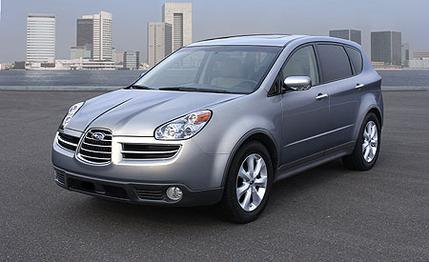
 First Drive Review
First Drive Review
Subaru owners are like malamutes. We don't mean to imply that they have fluffy, long hair or that they thrive in frigid weather or that they bounce when they walk-okay, maybe we are implying that-but rather that they are loyal. Plain and simple: They love their cars so much they lapse into baby talk and call them Subies. According to J.D. Power and Associates, 48 percent of Subaru owners buy another Subie. That might not suggest remarkable dedication, but among Japanese brands, only Toyota, Lexus, and Honda have a higher retention rate. Moreover, brands such as Acura, Audi, Infiniti, Nissan, and Porsche all trail Subaru in brand loyalty.
But unless you can keep 100 percent of your customers, there's always room for improvement. For Subaru, it's evident that more than half of its owners subsequently move on to different brands. The impetus? Well, the most obvious is that Subaru does not offer a vehicle that seats more than five. Subaru owners may be diehards, but they have their limits (or is it minimums?). So, with both the Outback wagon and Forester SUV capable of holding just five Phish fans, the only solution was to build a new tour bus.
That vehicle is the B9 Tribeca, the seven-passenger SUV you see here (a five-passenger Tribeca will also be available). The name is derived from Robert De Niro's cool neighborhood in New York City, which is an area called the "TRIangle BElow CAnal Street." Subaru just liked the name-there are no hidden meanings. As for Tribeca's leading partner, B9, it was lifted from the brand's recent concept cars-in particular the B9 Scrambler shown at the 2003 Tokyo motor show-and is a reminder of Subaru's new aeronautical face, whose air intakes are supposed to suggest a fuselage and wings. (Subaru's parent company, Fuji Heavy Industries, manufactured aircraft in the past.)
The Tribeca is based on an Outback platform with the wheelbase extended 3.1 inches to make room for a third row of seating. The front struts are adopted from the Outback, too, but the rear control-arm setup is unique to the B9. Subaru passed on the Outback's rear multilink arrangement because the control arms offered better stability and comfort in a vehicle of the B9's mass (4300 pounds), according to Subaru, and allowed for integration of a flat floor.
At 189.8 inches, the B9 is just over an inch longer than the Outback but is more than four inches wider (73.9) and almost five inches taller (66.4). The B9 is similarly sized to the first-generation Toyota Sienna minivan and falls neatly between the Nissan Murano and Toyota Highlander in every exterior dimension except length, in which it surpasses them by 2.2 and 5.2 inches, respectively.
Step inside, and the B9 is not only the biggest Subaru ever, but it's arguably the plushest. We drove a preproduction seven-passenger test mule and found the interior materials and fit and finish to verge on luxurious, especially with the optional leather-trimmed seats. Furthermore, the dash sports a stylistically modern design that sweeps from A-pillar to A-pillar, incorporating metallic-look trim, a prominent two-gauge pod, dual-zone A/C, and a seven-inch screen that'll direct you to the closest Whole Foods Market if the car is equipped with the available navigation system. For second- and third-row occupants, there's an optional DVD entertainment system that includes a ceiling-mounted nine-inch screen-perfect for enjoying the Grateful Dead's View From the Vault-and two wireless headphones. Passengers in the 40/20/40-split second row can slide their seats nearly eight inches fore-and-aft, although the two outcasts seated in the 50/50-split third row must do with fixed seats. The third row's lack of legroom and relatively flat cushions make adult habitation unseemly; kids, however, should fit. The second row offers enough room for at least two adults to ride in comfort. Configured for five or seven inside, the B9 protects with front-seat front and side airbags and curtain airbags for all outboard occupants.
Motivated by the Outback's 3.0-liter flat-six-good for 250 horsepower and 219 pound-feet of torque-and five-speed automatic transmission, the Tribeca wasn't designed for speed but to haul more passengers and cargo. The 3.0 is a rev-happy engine that displays a smooth, refined character, but it lacks the low-end grunt to feel quick off the line, even with Subaru's so-called symmetrical all-wheel-drive system delivering power to the 255/55R-18 Goodyear Eagle LS2s. The flat-six does shine at speed, however-say, when making a pass on the highway-and possesses enough power to justify the "sport" in SUV. With communicative steering, four-wheel disc brakes with ABS, and big footprints, the B9 is impressively flat through turns and treats passengers to a compliant ride that still offers enough firmness to encourage you to take the back roads to Woodstock.
Subaru remains mum on pricing but admits the B9 Tribeca, which will be built in Lafayette, Indiana, will retail for more than an Outback 3.0 L.L. Bean wagon, which starts at $32,870, so expect stickers to reside in the mid-30s when the vehicle goes on sale in early summer. With competitive pricing and room for seven, the B9 Tribeca demonstrates to current Subaru owners what they've been showing the brand for years-loyalty.